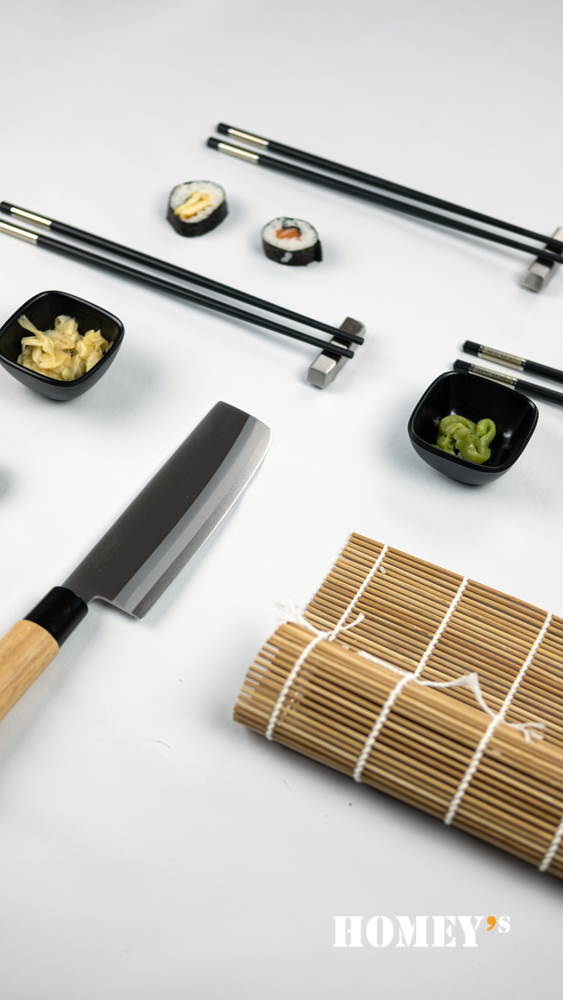Posted by Rosalie on 26th Oct 2020
4 most important tips to make homemade sushi a success
Some insights on making sushi
It would be a huge mistake to assume that sushi-making can be taught in one small article, let alone by us. If you aren’t a Japanese person, you have no statement to make about making sushi at all. We’d say: leave it to the experts. Luckily enough, some experts share their wisdom online, which will function as the sources of this article. We’d like to share some insights and handy tips and tricks about making sushi.
Step 1: buy great fish
Unless you plan to buy a super freezer, stick to sashimi-grade fish. “Sashimi-grade” or “sushi-grade” means that the fish has been frozen very cold and very quickly to ensure a) the swift and thorough death of parasites and b) that large ice crystals don’t form and ruin the texture of your fish. While tuna and salmon are common, they’re often farmed or poorly stored, and thus, meh-tasting. Go beyond! Look into what’s local, sustainable, and in season.
A few important things: look for filets that are bright (not dull), firm (not mushy), and not at all stinky.
Step 2: treat it right!
Now that you’ve bought your fish, think twice before you take your Yanagi (sushi/sashimi chef’s knife) to it! Using fresh fish for sushi (as opposed to preserved) is actually a relatively new development in the history of sushi, and just one of six types of sushi out there. You might also consider:
Curing
Wrap filets in sheets of konbu wetted with sake, or if you’re pressed for time, layer thin slices of fish between dry konbu sheets. Leave to cure for at least 1 hour, and up to … well, it’s up to you. After an hour, the fish will be slightly firm and will have taken on a faint aroma of the sea. After 3 days, the fish will be very firm, bouncy even, and more aggressively seasoned. This works best on delicate-tasting and textured fish, like porgy.
Pickling
Oilier, darker-fleshed fish - like mackerels - take well to pickling. Marinate boned filets in a 1:1 mixture of mirin and sake, and let hang out for at least 10 minutes. The longer you pickle, the firmer, and more thoroughly opaque the flesh.
Step 3: make good rice
If you have one, I’d highly recommend using a rice cooker for sushi. (You can even select the “sushi” function! It definitely doesn’t do anything different, but hey - when else do you get to use it?)
Seasoning rice
Okay, welcome back. Now that your rice grains are perfectly steamed and fluffed, it’s time to season them with rice vinegar, which has itself been seasoned. I like a ratio of 3 parts unseasoned rice vinegar to 2 parts sugar to 1 part salt (all by weight). Bring it to a boil - under a hood or with a window cracked, please, to spare your eyeballs - and cook, stirring until all of the sugar is dissolved. Remove from heat, and for a little something special, float in wide swatches of orange peel to infuse while it cools.
So, ideally, you’d now transfer a portion of your perfect rice into a hangiri, a shallow-sided wooden tub. This is so that you can “cut in” the seasoned vinegar with a rice paddle, as the hangiri wicks away excess moisture and cools the rice. But those things aren’t cheap, so if you don’t have one, a large mixing bowl will work just fine.
Step4: (caution!): slice, don’t saw
The big event - let’s go! Sharpen your longest knife (no, a serrated bread knife will NOT work here). You want to “pull” your knife back and through, working from the heel of the blade to the tip, as you slice the Saku block against the grain. Keep your slicing-hand wrist totally still and straight, and drive your elbow back as you slice. Don’t saw through the flesh; if you feel stuck, just pull the knife up and out, and restart. Wipe your knife clean, frequently, to prevent dragging and tearing the flesh. It’s not an easy technique but it’s definitely worth it training your skills on this.
Tip: Wet your knife with a wet towell before cutting




